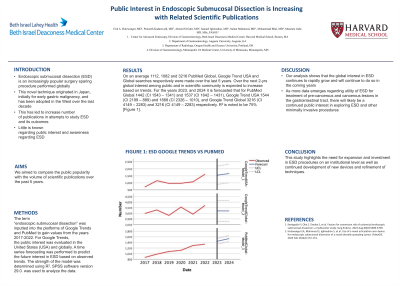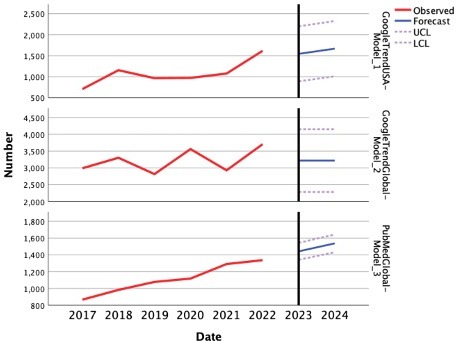Monday Poster Session
Category: Interventional Endoscopy
P2291 - Public Interest in Endoscopic Submucosal Dissection Is Increasing with Related Scientific Publications
Monday, October 23, 2023
10:30 AM - 4:15 PM PT
Location: Exhibit Hall

Has Audio
- EH
Erik Holzwanger, MD, ABOM-D
Center for Advanced Endoscopy, Beth Israel Deaconess Medical Center, Harvard Medical School
Boston, MA
Presenting Author(s)
Erik Holzwanger, MD, ABOM-D1, Praneeth Kudaravalli, MD2, Ahmed Gabr, MD3, Samuel Igbinedion, MD1, Sultan Mahmood, MD4, Mohammad Bilal, MD5, Moamen Gabr, MD, MSc,4
1Center for Advanced Endoscopy, Beth Israel Deaconess Medical Center, Harvard Medical School, Boston, MA; 2Augusta University, Augusta, GA; 3Oregon Health & Science University, Portland, OR; 4Beth Israel Deaconess Medical Center, Boston, MA; 5Minneapolis VA Medical Center, Minneapolis, MN
Introduction: Endoscopic submucosal dissection (ESD) is an increasingly popular surgery sparing procedure performed globally. This novel technique originated in Japan, initially for early gastric malignancy, and has been adopted in the West over the last decade. This has led to increase number of publications in attempts to study ESD and its outcomes. However, little is known regarding public interest and awareness regarding ESD. To further investigate this trend, we aimed to compare the public popularity with the volume of scientific publications over the past 5 years.
Methods: The term “endoscopic submucosal dissection” was inputted into the platforms of Google Trends and PubMed to gain values from the years 2017-2022. For Google Trends, the public interest was evaluated in the United States (USA) and globally. A time series forecasting was performed to predict the future interest in ESD based on observed trends. The strength of the model was determined using R2. SPSS software version 29.0. was used to analyze the data.
Results: On an average 1112, 1082 and 3216 PubMed Global, Google Trend USA and Global searches respectively were made over the last 5 years. Over the next 2-yrs global interest among public and in scientific community is expected to increase based on trends. For the years 2023, and 2024 it is forecasted that for PubMed Global 1442 (CI 1543 – 1341) and 1537 (CI 1642 – 1431), Google Trend USA 1544 (CI 2199 – 889) and 1668 (CI 2326 – 1010), and Google Trend Global 3216 (CI 4149 – 2283) and 3216 (CI 4149 – 2283) respectively. R2 is noted to be 75% [Figure 1].
Discussion: Our analysis shows that the global interest in ESD continues to rapidly grow and will continue to do so in the coming years. As more data emerges regarding utility of ESD for treatment of pre-cancerous and cancerous lesions in the gastrointestinal tract, there will likely be a continued public interest in exploring ESD and other minimally invasive procedures. This highlights the need for expansion and investment in ESD procedures on an institutional level as well as continued development of new devices and refinement of techniques.

Disclosures:
Erik Holzwanger, MD, ABOM-D1, Praneeth Kudaravalli, MD2, Ahmed Gabr, MD3, Samuel Igbinedion, MD1, Sultan Mahmood, MD4, Mohammad Bilal, MD5, Moamen Gabr, MD, MSc,4. P2291 - Public Interest in Endoscopic Submucosal Dissection Is Increasing with Related Scientific Publications, ACG 2023 Annual Scientific Meeting Abstracts. Vancouver, BC, Canada: American College of Gastroenterology.
1Center for Advanced Endoscopy, Beth Israel Deaconess Medical Center, Harvard Medical School, Boston, MA; 2Augusta University, Augusta, GA; 3Oregon Health & Science University, Portland, OR; 4Beth Israel Deaconess Medical Center, Boston, MA; 5Minneapolis VA Medical Center, Minneapolis, MN
Introduction: Endoscopic submucosal dissection (ESD) is an increasingly popular surgery sparing procedure performed globally. This novel technique originated in Japan, initially for early gastric malignancy, and has been adopted in the West over the last decade. This has led to increase number of publications in attempts to study ESD and its outcomes. However, little is known regarding public interest and awareness regarding ESD. To further investigate this trend, we aimed to compare the public popularity with the volume of scientific publications over the past 5 years.
Methods: The term “endoscopic submucosal dissection” was inputted into the platforms of Google Trends and PubMed to gain values from the years 2017-2022. For Google Trends, the public interest was evaluated in the United States (USA) and globally. A time series forecasting was performed to predict the future interest in ESD based on observed trends. The strength of the model was determined using R2. SPSS software version 29.0. was used to analyze the data.
Results: On an average 1112, 1082 and 3216 PubMed Global, Google Trend USA and Global searches respectively were made over the last 5 years. Over the next 2-yrs global interest among public and in scientific community is expected to increase based on trends. For the years 2023, and 2024 it is forecasted that for PubMed Global 1442 (CI 1543 – 1341) and 1537 (CI 1642 – 1431), Google Trend USA 1544 (CI 2199 – 889) and 1668 (CI 2326 – 1010), and Google Trend Global 3216 (CI 4149 – 2283) and 3216 (CI 4149 – 2283) respectively. R2 is noted to be 75% [Figure 1].
Discussion: Our analysis shows that the global interest in ESD continues to rapidly grow and will continue to do so in the coming years. As more data emerges regarding utility of ESD for treatment of pre-cancerous and cancerous lesions in the gastrointestinal tract, there will likely be a continued public interest in exploring ESD and other minimally invasive procedures. This highlights the need for expansion and investment in ESD procedures on an institutional level as well as continued development of new devices and refinement of techniques.

Figure: ESD Google Trends vs. Pubmed
Disclosures:
Erik Holzwanger indicated no relevant financial relationships.
Praneeth Kudaravalli indicated no relevant financial relationships.
Ahmed Gabr indicated no relevant financial relationships.
Samuel Igbinedion indicated no relevant financial relationships.
Sultan Mahmood indicated no relevant financial relationships.
Mohammad Bilal: Boston Scientific – Consultant.
Moamen Gabr: Adaptive Endo – Consultant. Boston Scientific – Consultant. ConMed – Consultant. Fuji – Consultant. Medtronic – Consultant. Olympus – Consultant.
Erik Holzwanger, MD, ABOM-D1, Praneeth Kudaravalli, MD2, Ahmed Gabr, MD3, Samuel Igbinedion, MD1, Sultan Mahmood, MD4, Mohammad Bilal, MD5, Moamen Gabr, MD, MSc,4. P2291 - Public Interest in Endoscopic Submucosal Dissection Is Increasing with Related Scientific Publications, ACG 2023 Annual Scientific Meeting Abstracts. Vancouver, BC, Canada: American College of Gastroenterology.
